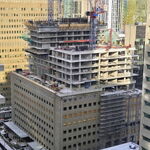I'll bite...........but if you're not trolling, I would like you to identify the streets in question, and show before and current travel times on route.
A discussion like this needs to be evidence based. You're dismissing someone else's anecdote, seemingly for lack of evidence, while not providing any of your own.
I'll be happy to engage in constructive dialogue (this is not a thread for anti-bike lane rhetoric); but constructive means bring the proof, bring the ideas and concepts you'd prefer, and I'll be happy to have a polite and thoughtful exchange of views.
How can you take a city that has grown tremendously in recent years and reduce traffic capacity by 50% on roads where lanes have been removed in order to create bike lanes and not expect increased congestion and travel times.
There is a straight-forward answer to this, believe it or not, which is three-fold.
1) You need to consider all the times at which the road is not and was not congested, not just 2am, but 2pm, and Sunday morning. In other words, there may (or may not) be more congestion or longer travel times at select periods (say rush hours), but that doesn't necessarily apply at most or all times.
2) You need to consider than most 4-lane roads that were reconfigured with cycle tracks actually operated as 2-lane roads 22 hours per day M-F and 24/7 on the weekend with parking on both sides of the street, and even in rush hour in one direction.
So the cut in capacity is not 50% in that scenario, its 50% for 10 hours per week.
3) To the extent that congestion has increased, or might increase because a road was close to capacity already at rush hour, the assumption is that at least some drivers will switch modes of travel (bike, walk, transit), and that others will switch routes. This then lessens the impact in question.
Now that does not mean it eliminates the impact. But here's where we need evidence, how much slower is 'road 'x'' and is that because of the bike lane, or something else like the construction on the Gardiner in the west end?
Only once we know this, can we discuss what mitigation may be appropriate.
Toronto streets were not originally designed to accommodate bike lanes and lanes for cars)
True, Also true, most Toronto streets that were 4 lanes in the year 2000, were only 2 lanes in 1950. The City ripped out tree-lined boulevards and expropriated pieces of people's front lawns to widen the roads to make more room.
Change is a constant in life. Not all of it is good; and regardless most is difficult to accept at first. Sometimes, change is regrettable. If you asked all those homeowners if they'd prefer a larger lawn and a tree-lined boulevard, I'm betting many would go for that.
Of course some things are lost to history, and I'd be careful about dreaming of a different age, as that's not the one we're in now.
Toronto traffic planners are either the worst in the world at what they do (if their intentions are to expedite as much traffic as safely and efficiently as possible) or the best in the world at what they do (if their intentions are to impede traffic flow through every possible means...bike lanes, cafe TO, street cars, dedicated LRT lanes).
What if their object is to
move people, rather than cars?
Its possible that the goal is to move people as quickly as possible, but not necessarily the same way we are used to.
There are some simple changes that could make a difference but the politicians and bureaucrats do not have the courage to do it.
Which ones?






